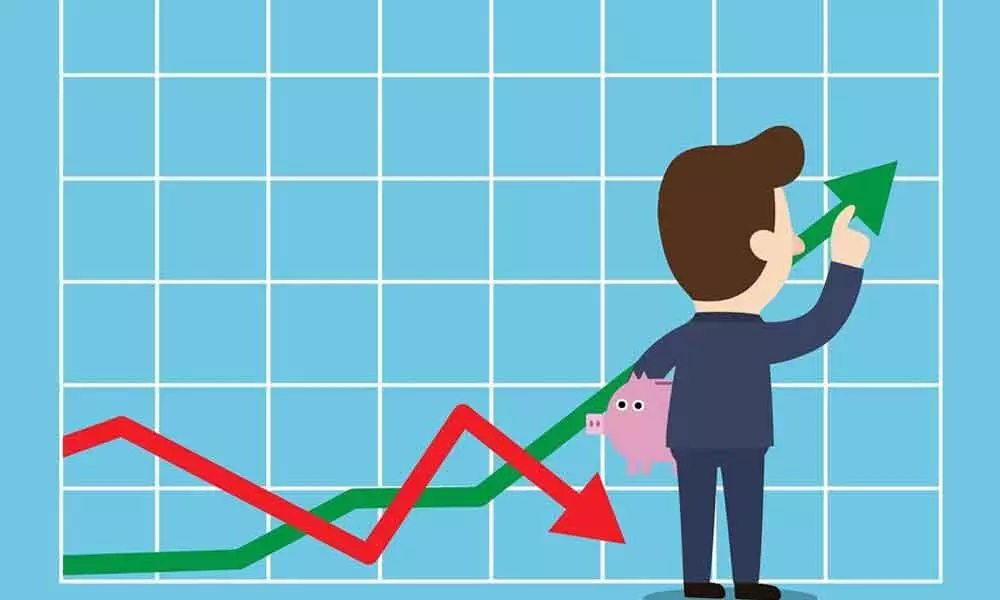Live
- They always want me to win, and now I feel lucky to have been offered a story like ‘Zebra’: Satyadev Kancharana
- ‘Democracy first, humanity first’: PM Modi in Guyana's parliament on two countries' similarities
- PKL Season 11: Telugu Titans register third straight win to top standings
- Is Pollution Contributing to Your COPD?
- NASA Unveils Underwater Robots for Exploring Jupiter's Moons
- Additional Central forces arrive in violence-hit Manipur
- AR Rahman and Saira Banu’s Divorce: Legal Insights into Common Issues in Bollywood Marriages
- 82.7 pc work completed in HPCL Rajasthan Refinery area: official
- Curfew relaxation extended in 5 Manipur districts on Friday
- Tab scam prompts Bengal govt to adopt caution over fund disbursement
Just In
Why markets rising despite falling GDP?


Why markets rising despite falling GDP?
The market-economy disconnect has puzzled many investors and others alike on how the markets continued their flight even as the rest of the public is in a plight
The last one year we've witnessed virtual shutdown of our lives for more than a month, withstood the worst health scare in over a century and then fighting back to normalcy. During this phase education, entertainment, work and the way we live overall have drastically transformed.
We've stitched our lives around the raging waves of the pandemic and began to adjust to it. There's a large scale of employment loss, income shocks and livelihood among many households across the country.
The Indian economy has registered its first negative growth in decades and impacting the govt. revenues. The stock market, however, after the initial sudden crash in last March is on a constant fire notching up new highs every quarter since.
The burning question of late has been on why the stock markets are so disjointed from the real economy. This has puzzled many investors and others alike on how the markets continued their flight even as the rest of the public is in a plight.
First, we need to understand that the economic indicators are lagging (sas they're announced post the happening) while stock markets could be considered as leading indicators (as they discount future possibilities).
On that count, while the economy is under shock, the stock markets are pricing-in recovery and potential higher growth from here on. This might still not answer entirely the behavior of the markets. But, are the stock indices an appropriate representation of the Indian economy?
If we look at the composition of NIFTY 500 the broader benchmark versus the Indian sector composition to GDP, there's a vast difference. Financial Services as a sector which occupies a lion's share at close to a third in the stock market benchmark contributes only a mere 6 per cent to the GDP. Construction which forms about 2 per cent of the stocks provides about 7 per cent in real GDP.
While taking advantage of the lower interest rates and easy liquidity conditions, quality corporate on their part got their act together. In pursuit of profitability, they managed to reduce costs, turn more productive and deleveraged their balance sheets. These actions not only ensured their survivability but also increased their earnings furthering their prosperity which called for rerating in their stock prices.
As the economy slowly opened, the demand slowly progressed enabling capacity utilizations. The levers of improved productivity, increased margins and capacity utilizations in place, the pace of recovery was swift and quick.
The quality businesses now sat on a vantage to capture the larger opportunity vacated by the informal sector (the very factors that were boon the formal economy turned bane to the informal one) making the big companies to grow bigger. Many of the listed companies thus became the beneficiaries of this largesse of disproportionate market share gains.
The unsynchronized re-opening of the economy also created supply chain issues creating scarcity in the form of goods and even transportation of them. These clogs at various points of the value chain have spiked the inflation (which was benign for a long while) helped post better earnings by the companies.
More importantly, the depressed interest rates also drove investors hunting for better yields to diversify into stock markets. The risk premia between the high yield debt and sovereigns have shrunk with reduced real returns in safer assets.
As the near-term interest rates have turned negative or zero, investors veered to higher yields started to allocate a bit towards equity and other riskier assets, triggering an asset reflation benefiting stock markets.
The current stock market valuations have embedded continued congenial monetary regime and lower future rates while the extraordinary liquidity conditions have only supplemented the mania. In summary, though the stock markets are not an exact mirror of the prevailing economic conditions, the current rally in the markets were abetted by some fundamental changes adopted by the corporate while the rest is fueled by the actions taken to alleviate gloomy situation.
On the question of how long this would continue, one must remember that the future returns are a function of current prices and liquidity. As the excesses turn worse into inflationary pressure and the underlying (assumed) conditions change the whole cycle could reverse very rapidly.
(The author is a co-founder of "Wealocity", a wealth management firm and could be reached at [email protected])

© 2024 Hyderabad Media House Limited/The Hans India. All rights reserved. Powered by hocalwire.com






